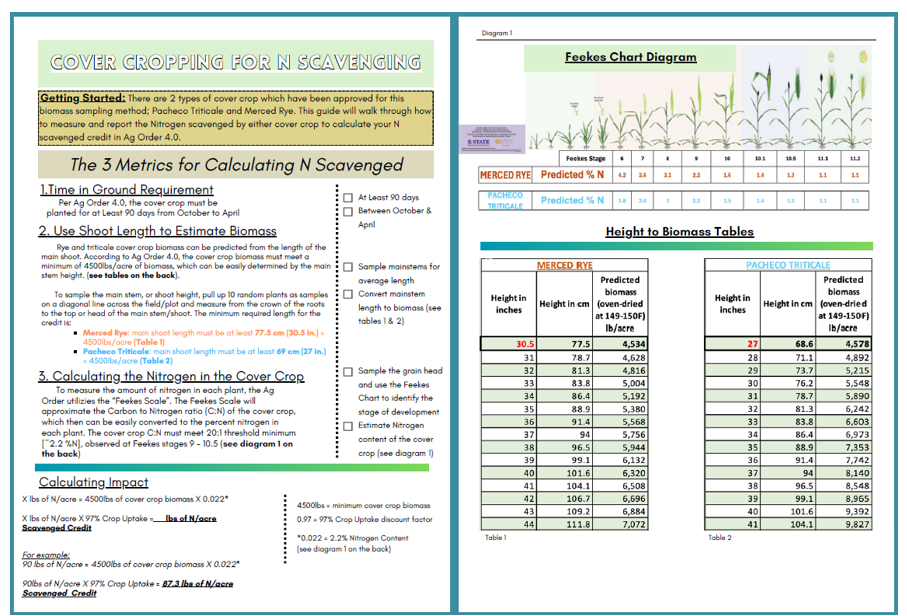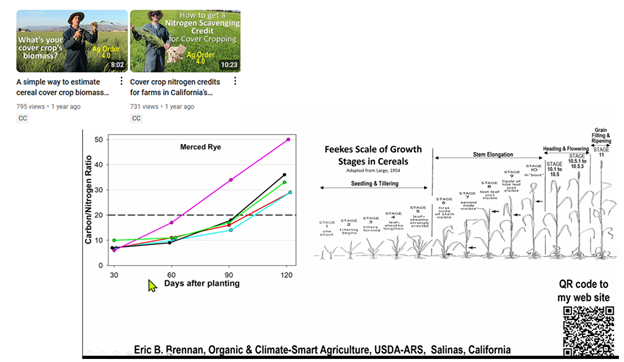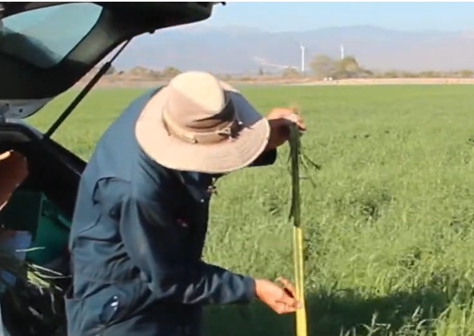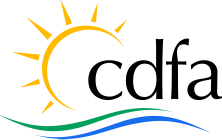Note: This is part of a Research Update series highlighting projects funded by the annual, competitive grant of the California Department of Food and Agriculture (CDFA) Fertilizer Research and Education Program (FREP).
Project Title: Facilitating Grower Adoption of Cover Crop Nitrogen Scavenging to Minimize Residual Nitrogen Loss and Comply with the Irrigated Lands Water Quality Protection Program (Ag Order 4.0) on the Central Coast of CA
Project Lead: Sacha Lozano (Resource Conservation District of Santa Cruz County)
Project Status: Year 2(3-year project)
Project Location: Central Coast
Overview
This FREP-funded project delivers updates on the use of nitrogen (N)- scavenging cover crops as a strategy to reduce residual N losses and help growers comply with water quality regulations through the Irrigated Lands Regulatory Program to protect groundwater quality on the Central Coast of California.
Background
Specialty crop rotations on California’s Central Coast rely heavily on N inputs, leaving considerable amounts of residual N vulnerable to leaching during winter rains. This not only drives up production expenses but also poses risks to water quality and public health. Cover cropping is a proven soil management strategy that recaptures and recycles excess N, reducing fertilizer demand while supporting compliance with water quality regulations. The 2021 Ag Order 4.0 (now remanded to the State Water Board for revision) introduced incentives by allowing growers to credit N scavenging from winter cover crops toward their N balance requirements. While regulatory uncertainty remains, continued research, outreach, and technical assistance are encouraging wider adoption of cover crops to enhance nutrient management and environmental stewardship. This project aims to equip Central Coast growers with practical knowledge of a validated, field-based method to estimate biomass and the carbon-to-nitrogen (C:N) ratio of winter cereal cover crops, helping them demonstrate residual N recovery through cover cropping.
Approach
The project team has worked one-on-one with participating growers and Certified Crop Advisers to communicate lessons learned from recent research trials and demonstrate practical guidelines to adopt a methodology to easily and confidently estimate cover crop N recovery. They have also provided technical guidance on winter cover crop planting, crop and residue management, and hosted two field days and several grower meetings focused on the N removal credit in Ag Order 4.0 and best management practices for maximizing N credit through cover cropping with cereals.
Accomplishments
To date, the team has collaborated one-on-one with 34 growers to discuss the concept of N-scavenging cover crops and explain how cover crops can improve N management practices while protecting water quality. All 34 growers established cereal cover crops in October–December 2024, which were later used in February–March 2025 to demonstrate a practical, field-based method for estimating biomass, determining the C:N ratio, and calculating N recovery within the framework of Ag Order 4.0.

Pictured is a simplified practical interim guide for quantifying cover crop N scavenging, pending updates based on new research data from Dr. Eric Brennan (USDA-ARS technical advisor).
Educational videos previously created by Dr. Eric Brennan from the U.S. Department of Agriculture Agricultural Research Service (USDA-ARS) were shared with growers to introduce them to the proposed concepts and methodology related to cover crop N scavenging. The project team worked with participating growers to guide winter cover crop plantings on selected fields at their ranches and provided cost-share assistance.

Snapshots of Dr. Eric Brennan’s educational videos about cover crop N scavenging used in the project’s education events.
In addition, the team utilized soil nitrate quick tests and took soil samples for lab analysis to establish a soil N baseline before cover crop planting on all participating ranches. They also advised and guided participating growers to ensure adequate cover crop planting and establishment (Nov-Dec 2024).
The project team hosted two field events and presented at one virtual outreach event on general aspects and benefits of winter cover cropping, their N scavenging potential, and how to successfully manage cereal cover crops to obtain the maximum allowable credit in Ag Order 4.0. In addition, the project team hosted two educational events focusing on general aspects and benefits of winter cover cropping; one of the events was conducted in partnership with Kitchen Table Advisors (KTA) and targeted a group of seven farming operations (KTA clients) who are co-managing an 87-acre ranch.
The project team has worked with technical advisors to develop a draft outreach document in English and Spanish to be used in grower training and educational events, and maintained communication with staff from agricultural industry groups, grower and shipping companies, and academic researchers working on the Central Coast region, to identify and coordinate opportunities for cover crop and N management education and outreach events covered by this project.

Dr. Eric Brennan demonstrating rye sampling procedures to estimate cover crop shoot biomass.
Project Impacts
Thirty-four farming operations have been enrolled in the project. All these operations have expressed interest in gaining more knowledge and skills related to the application of winter cover crops and their multiple benefits, including, but not limited to their ability to recycle N and protect water quality. All participating growers planted a cereal cover crop in 2024 and will participate in educational events and one-on-one trainings in 2025 to learn how to take simple measurements that can be used to estimate the cover crop biomass and C:N ratio and calculate the amount of recycled N (pounds of N per acre).
This blog post presents a summary of this project and some of its findings and does not include all the data collected in this study. The complete report will be published, tentatively in 2027, where other completed FREP projects are available on the FREP Research & Project Database. If interested in receiving further details about this project in the meantime, please email FREP@cdfa.ca.gov.


